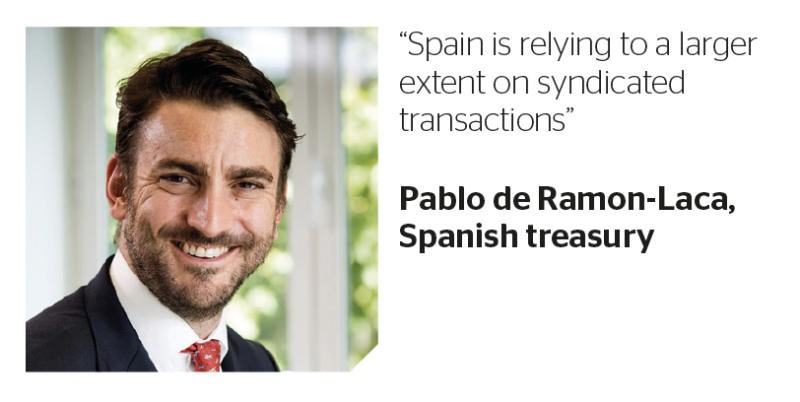I can’t really compare it to anything in my entire career,” Sir Robert Stheeman, chief executive of the UK Debt Management Office, told GlobalCapital in June. “If you had told me at the end of February that we would find ourselves in this situation physically, literally, remotely, today — but also, I suppose, fiscally, financially and with a borrowing requirement that looks very different from what we were envisaging ahead of the March Budget — I would have said maybe it’s time to sit down and relax and let the moment pass.”
Unfortunately, the moment didn’t pass and by October the UK had been forced to borrow £260.8bn to cover the gap between its income and its spending since the new financial year began in April, with the country intending to borrow an eye-watering £485.5bn for the whole 2020/21 financial year. It’s worth noting that the Gilt programme for the year was originally envisaged to be £156bn.
Sir Robert, of course, wasn’t alone in questioning reality. Sovereign bond markets across the world have had to step up this year as astronomically expensive employment support schemes, health services in desperate need of equipment and falling tax revenues have combined to create huge, yawning deficits.

Fortunately, investors’ resources have proven more than equal to the challenge and, for much of the year, governments have tapped markets at superb funding costs, despite the unprecedented frequency and intensity of their borrowing.
With news of vaccines in development, one would hope that the burden in 2021 will not be so great, but many challenges still exist. “Sovereign borrowing in 2020 was driven mainly by the emergency measures put in place on the back of lockdowns,” says Ben Adubi, Morgan Stanley’s head of SSA syndicate. “The vaccine is positive news, of course, but until it’s actually rolled out, lockdowns won’t be relaxed, so at least in the early part of 2021, we will be just as active as the peaks of 2020.”
What’s more, deficits were not all financed in term debt markets. Money markets played a colossal role in providing the upfront cash required to finance furlough schemes and other social safety nets.
While they were more than up to the task, much of the debt will fall due in 2021 and must be refinanced as longer-term debt.
“A lot of funding needs were met by bills — BTFs in France, BuBills in Germany — and the overall outstanding amount of short term sovereign debt has increased,” says Olivier Vion, head of SSA syndication and DCM at Société Générale. “In terms of redemptions and deficits, sovereign’s needs in 2021 will be smaller, but terming out CP will make up for some of that.”
Threats to deficits remain a factor and sovereigns have backlogs of money market debt to work through, but despite these concerns, 2021 should still be a lighter load than 2020, at least for sovereigns. “We ended up more than double 2019’s syndications in 2020, something around 230%,” says Jamie Stirling, global head of SSA DCM at BNP Paribas. “We don’t expect the same volume in 2021, but it will certainly be larger than previous years.”
ECB aids digestion
The European Central Bank has been instrumental in preserving market access for Europe’s sovereigns this year. When coronavirus ripped into Europe in early March, markets ground to a halt and spreads gapped out alarmingly.

Market access would likely have been constrained and sovereigns unable to raise the funds necessary to support their economies through lockdowns if it were not for the ECB’s rescue package: the Pandemic Emergency Purchase Programme — €1.35tr (in December increased to €1.85tr) of asset purchases unconstrained by the capital key.
The effect was almost instantaneous. After some four weeks of silence, Europe’s sovereigns quickly produced €30bn of supply in around a week.
Belgium was one of the issuers to take advantage of the change in tone, raising €8bn (its largest ever) with a seven year deal. Thanks in no small part to the ECB, Belgium was able to raise the funds with only an 8bp new issue premium.
Looking ahead to 2021, Jean Deboutte, director of strategy at the Belgian debt office, says: “We’re confident that the ECB will continue to support the market. Deficits are still very high for Belgium and for other countries, so I would be extremely surprised to see the ECB scale down its activities.
“It’s an excellent opportunity to lock in long dated funding at low rates.”
In what could well be a crowded year, the ECB’s support will be crucial to ensure that investors are able to process the supply. “The ECB has demonstrated that it has the tools to step in and deal with indigestion,” says Adubi.
Its interventions have driven yields to record lows, including sending Portugal’s curve into negative territory out to 10 years at the end of November, in spite of the fact that, thanks to the pandemic, the economic outlook has materially worsened. But investors seem undeterred by the scantiness of the yields on offer.
“Although the rates market is expensive, when you look at the market more broadly, there’s still value there,” says Adubi. “IG and high yield have enjoyed significant spread compression since April, and this has been accelerated by the vaccine.” In short, though historically expensive, the cheaper asset classes do not offer enough pick-up to poach investors away from the SSA asset class.
Europe’s aid
Europe also lent aid to sovereigns through fiscal means, as well as monetary policy. The Support to mitigate Unemployment Risks in an Emergency programme provides €100bn of loans to European sovereigns to support unemployment programmes.

For countries who pay a consistent spread to the EU’s funding level, the SURE loans offer cheap funding, but Belgium’s cost of funds is extremely similar to that of the EU’s. “There was some internal debate over whether the SURE loans would represent good value,” says Deboutte. “In the end, we applied and were granted €7.8bn and it is likely to offer a slight saving versus our own funding.”
Of course, the loans from the EU all carry a 15 year tenor and Belgium will not have control over when it receives the cash, but Deboutte believes that the loans will be worthwhile nevertheless. “It’s useful diversification, and it seems that the market has rewarded Belgium for taking the opportunity,” says Deboutte. “Our spread performance versus France, which did not take the loans, reflects that.”
Pablo de Ramón-Laca, director general of the Spanish treasury, welcomes the new “rich funding sources” but points out that their presence will “require a higher degree of flexibility on the issuance front”.
Next year, the Next Generation EU programme will, all being well, kick into gear. Over its life, it is intended to provide €750bn to Europe’s sovereigns. That will likely mean approximately €200bn per year over the next three to four years. That funding will, in all probability, reduce the sovereign funding burden by a commensurate amount.
However, the benefits will be distributed according to need, rather than an even distribution. Countries like Spain and Italy are set to receive more of the funding, reducing their need to use capital markets, while Belgium and France will receive little.
“Belgium is set to receive only a few billion if it comes,” says Deboutte. “So it will make little difference on our funding programme.”
Syndications versus auctions
The drastic change in sovereign borrowing requirements has led to a change in the attitudes of debt management office to syndications.
Previously, some DMOs looked on the syndication process as an expensive way of keeping their primary dealer group motivated to take down funds at auction at a loss.
“Debt offices used to treat syndications as an incentive to keep the banks interested,” says Vion. “But in 2020, they’ve realised that it can be an interesting and useful format in its own right.”
Syndication allowed sovereigns to raise amounts of cash that would have been challenging at auction. Vion adds: “Countries would likely have had to do multiple auctions to achieve the results they have with syndications.”
Certain maturities are also challenging to access via auction in the sizes that sovereign issuers are looking for, and, as a result, several sovereigns have expanded the range of tenors that they access through syndications. The UK DMO, for example, syndicated new 10 year bonds for the first time in 2020.
De Ramón-Laca says Spain is “relying to a larger extent on syndicated transactions”.
The other benefit of syndications is the improved transparency. With auctions, DMOs have little way of knowing where their bonds end up. With syndications, they can see every investor. This is valuable for every deal, but particularly for those with green labels.
“That was hugely important for Germany,” says Adubi. Using the syndication format ensures the Finanzagentur can see it is reaching marginal green investors who are key to executing a successful green trade.
The amount of cash raised through sovereign syndications has rocketed this year, exceeding $500bn by the end of November — approximately double the amount raised in the next busiest year in the format: 2009. GC





